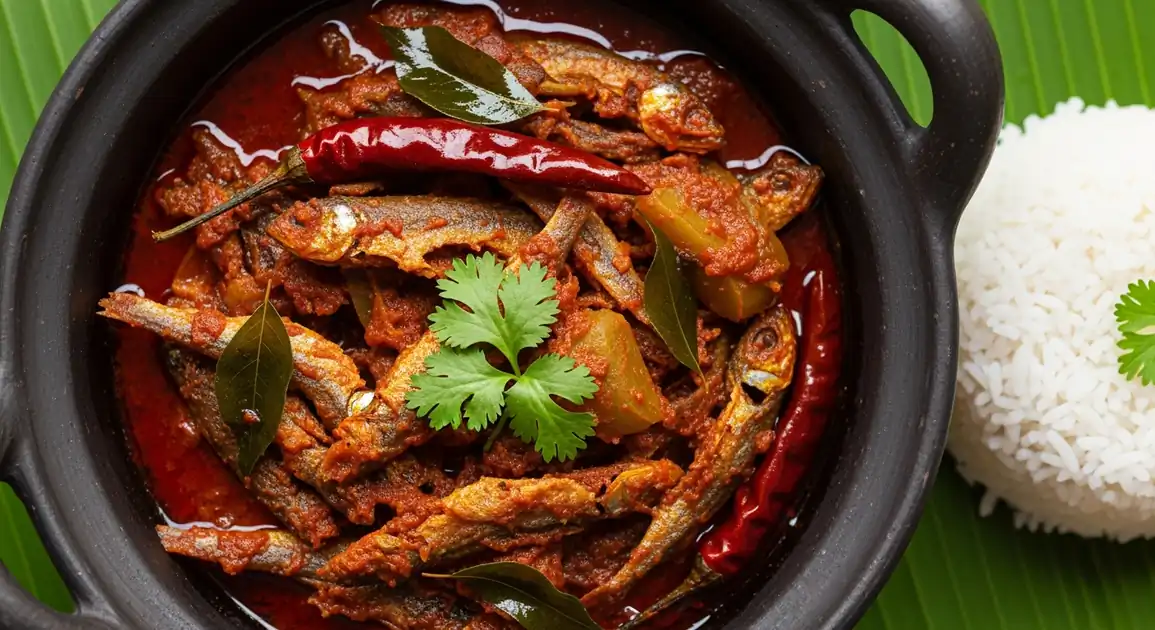Hal Messo (Fish Curry)
හාල් මැස්සෝ

Description
Hal Messo is a beloved dish throughout Sri Lanka, particularly in coastal regions where fresh fish is abundant. The dish reflects the island's maritime heritage and spice-rich culinary tradition. While regional variations exist, the fundamental elements of spicy, tangy fish curry remain consistent nationwide.
Dietary Information
Serving information
Serving style
Traditionally served in a clay pot or small bowl alongside rice on a banana leaf or plate. Often accompanied by several vegetable curries and sambol (spicy condiments).
Quick facts
Lunch places typically serve from 11 AM - 3 PM. Evening vendors often operate from 6 PM - 10 PM.
Safety Tips
What to Look For
-
Clear, vibrant red curry sauce with visible spices
Quality Hal Messo has a distinct red-orange color from fresh spices, not a dull or brownish appearance which could indicate old spices or reheated curry.
-
Firm, intact fish chunks
The fish should hold its shape when lifted with a spoon, not fall apart easily. Mushy or disintegrating fish often indicates old or poor quality fish.
-
Fresh, aromatic smell of spices without fishiness
The dominant aroma should be of curry leaves, goraka, and spices. Any strong fishy smell suggests the fish isn't fresh.
-
Clay pot cooking (traditional method)
Clay pots help slow-cook the curry and develop flavors better than metal pots, often indicating more traditional preparation methods.
-
Visible curry leaves and pandan leaves
Fresh herbs are essential to authentic Hal Messo and indicate attention to traditional preparation.
What to avoid
-
Watery, thin curry sauce
Good Hal Messo has a somewhat thick consistency. Overly watery curry might indicate it's been diluted to stretch portions or hasn't been prepared properly.
-
Pre-cooked fish added to curry sauce
Traditional Hal Messo cooks the fish in the spice mixture. Some vendors take shortcuts by adding pre-cooked fish to sauce, resulting in less flavorful dishes.
-
Strong ammonia or fishy smell
This indicates the fish is not fresh and could potentially cause food poisoning. Fresh fish has a mild sea scent, not a strong fishy odor.
-
Floating oil with strange color
Excessive oil separation with unusual coloration could indicate old oil or curry that's been repeatedly reheated.
-
Very pale or grayish fish
Fresh tuna should have a pinkish to reddish-brown color when cooked. Gray or very pale fish suggests poor quality or old fish.
Price information
Price range
Budget tips
- Street vendors and local 'kadé' (small eateries) offer the most affordable options, typically 150-350 LKR per portion.
- Markets ('pola') often have food stalls serving freshly made Hal Messo at reasonable prices.
- Buying a 'rice and curry' meal that includes Hal Messo is more economical than ordering it separately.
Value indicators
- Visible chunks of fish (not tiny pieces).
- Thick, richly colored sauce (not watery).
- Served with fresh accompaniments like lime and chili.
- Made with yellowfin tuna rather than cheaper fish varieties.
- Cooked in traditional clay pots.
Where to Find This Dish
Coastal Areas
Fishing villages and beach towns offer the freshest versions made with the day's catch.
Fishing harbors, Beach strips, Coastal markets
Morning (after fishing boats return), Lunch
Markets
Weekly and daily markets (pola) feature food stalls with traditional curries.
Pettah Market, Rural weekly markets ('pola')
Morning, Midday
Traditional Eateries
Small local restaurants (kadé) specializing in rice and curry.
Local rice and curry shops, Family-run restaurants
Lunch (11 AM - 2 PM), Dinner (7 PM - 9 PM)
Vendor Tips
- Ask when the fish was purchased – same day is ideal.
- Look for places where locals are eating, especially fishermen in coastal areas.
- Some vendors will allow you to select your spice level – request 'sudda hal messo' for a milder version.
How to Order
Regional Variations
-
Amba Hal Messo
(අඹ හාල් මැස්සෝ)
A variation that includes green mango pieces, adding extra tanginess to balance the spice.
-
Coconut Hal Messo
(පොල් හාල් මැස්සෝ)
A milder version that incorporates coconut milk, creating a creamier texture and reducing the spice intensity.
-
Dry Hal Messo
(හිඳි හාල් මැස්සෝ)
A reduced, thicker version with less sauce, often more intensely flavored and spicier.
-
Black Hal Messo
(කළු හාල් මැස්සෝ)
A distinctive version using roasted spices and goraka, resulting in a darker color and deeper flavor profile.
-
Green Hal Messo
(කොළ හාල් මැස්සෝ)
Made with green chilies instead of red, and often incorporating more fresh herbs like coriander and mint.
Cultural context
History
Hal Messo has deep roots in Sri Lanka's coastal culinary tradition, evolving from the island's rich maritime heritage. The name derives from 'Hal' (rice) and 'Messo' (fish), reflecting its status as an essential accompaniment to rice meals. Historically prepared in coastal fishing communities, the recipe has been passed down through generations, with each family maintaining slight variations. The introduction of goraka as a preservative ingredient was crucial in times before refrigeration, allowing the curry to keep for several days.
Local significance
Hal Messo represents Sri Lanka's rich maritime heritage and complex spice tradition. It's considered a protein-rich staple that showcases the island's distinctive flavor profile of heat, tanginess, and aromatic spices.
Eating customs
- Eaten with rice, typically mixed by hand (using right hand only).
- Often accompanied by coconut sambol (pol sambol) and vegetable curries.
- Complemented with a squeeze of lime to balance the heat and aid digestion.